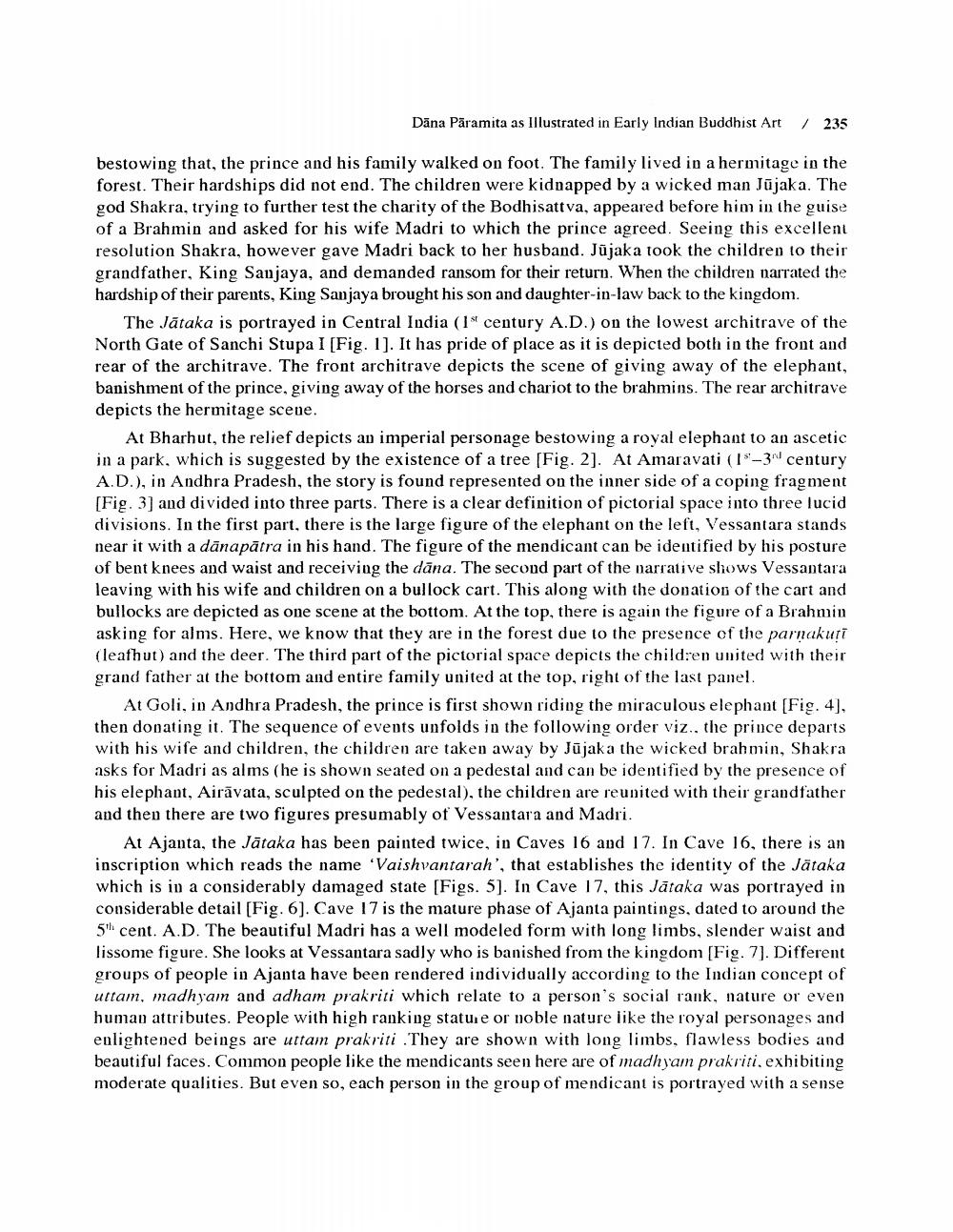________________
Dāna Päramita as Illustrated in Early Indian Buddhist Art
/ 235
bestowing that, the prince and his family walked on foot. The family lived in a hermitage in the forest. Their hardships did not end. The children were kidnapped by a wicked man Jūjaka. The god Shakra, trying to further test the charity of the Bodhisattva, appeared before him in the guise of a Brahmin and asked for his wife Madri to which the prince agreed. Seeing this excellent resolution Shakra, however gave Madri back to her husband. Jūjaka took the children to their grandfather, King Sanjaya, and demanded ransom for their return. When the children narrated the hardship of their parents, King Sanjaya brought his son and daughter-in-law back to the kingdom.
The Jātaka is portrayed in Central India (1st century A.D.) on the lowest architrave of the North Gate of Sanchi Stupa I (Fig. 1). It has pride of place as it is depicted both in the front and rear of the architrave. The front architrave depicts the scene of giving away of the elephant, banishment of the prince, giving away of the horses and chariot to the brahmins. The rear architrave depicts the hermitage scene.
At Bharhut, the relief depicts an imperial personage bestowing a royal elephant to an ascetic in a park, which is suggested by the existence of a tree (Fig. 2). At Amaravati (15-3 century A.D.), in Andhra Pradesh, the story is found represented on the inner side of a coping fragment [Fig. 3) and divided into three parts. There is a clear definition of pictorial space into three lucid divisions. In the first part, there is the large figure of the elephant on the left, Vessantara stands near it with a dānapātra in his hand. The figure of the mendicant can be identified by his posture of bent knees and waist and receiving the dāna. The second part of the narrative shows Vessantara leaving with his wife and children on a bullock cart. This along with the donation of the cart and bullocks are depicted as one scene at the bottom. At the top, there is again the figure of a Brahmin asking for alms. Here, we know that they are in the forest due to the presence of the parnakuri (leafhut) and the deer. The third part of the pictorial space depicts the children united with their grand father at the bottom and entire family united at the top, right of the last panel.
At Goli, in Andhra Pradesh, the prince is first shown riding the miraculous elephant (Fig. 4), then donating it. The sequence of events unfolds in the following order viz., the prince departs with his wife and children, the children are taken away by Jūjaka the wicked brahmin, Shakra asks for Madri as alms (he is shown seated on a pedestal and can be identified by the presence of his elephant, Airāvata, sculpted on the pedestal), the children are reunited with their grandfather and then there are two figures presumably of Vessantara and Madri.
At Ajanta, the Jātaka has been painted twice, in Caves 16 and 17. In Cave 16, there is an inscription which reads the name 'Vaishvantarah', that establishes the identity of the Jätaka which is in a considerably damaged state [Figs. 5). In Cave 17, this Jātaka was portrayed in considerable detail [Fig. 6). Cave 17 is the mature phase of Ajanta paintings, dated to around the 5th cent. A.D. The beautiful Madri has a well modeled form with long limbs, slender waist and lissome figure. She looks at Vessantara sadly who is banished from the kingdom [Fig. 7). Different groups of people in Ajanta have been rendered individually according to the Indian concept of uttam, madhyam and adham prakriti which relate to a person's social rank, nature or even human attributes. People with high ranking stature or noble nature like the royal personages and enlightened beings are uttam prakriti .They are shown with long limbs, flawless bodies and beautiful faces. Common people like the mendicants seen here are of madhyam prakriti. exhibiting moderate qualities. But even so, each person in the group of mendicant is portrayed with a sense




